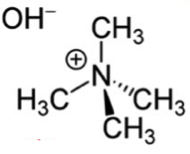Frequently Asked Questions
Everything you need to know about Life Bitmaps Project
What is TMAH?
Tetramethylammonium hydroxide (TMAH or TMAOH) is a quaternary ammonium salt with the molecular formula N(CH3)4+ OH− :

TMAH is most commonly encountered as an aqueous solution, in concentrations from ~2–25%, and less frequently as solutions in methanol. These solutions are identified by the CAS# 75-59-2. TMAH solutions are colorless, or yellowish if impure. Although TMAH has virtually no odor when pure, samples often have a strongly fishy smell from the trimethylamine which is a common impurity. No harmonized classification for this substance hasn't been provided according to the (CLP) Regulation (EC) N. 1272/2008 on classification, labelling and packaging of substances and mixture. Furthermore, for TMAH different classifications are reported by suppliers and manufacturers. Nevertheless, this strongly alkaline substance has been investigated in several studies that confirmed its corrosive properties for human tissues, the toxicity for the respiratory apparatus as well as in case of contact with skin or when swallowed and the ecotoxicity for invertebrates. TMAH has numerous industrial and research applications.
What type of wastewater containing TMAH is treated by the biological section of BITMAPS pilot plant?
The TMAH waste solution collected at LFoundry semiconductors site of Avezzano, originated from the photolithography process which uses that substance for the photoresist removal from the silicon wafer surface. Within the wastewater treatment performed by the BITMAPS pilot plant, the stripped photoresist represents a carbon source for the growth of the microorganisms carrying out a biological degradation of TMAH.
From which process chemicals originates the acid mix waste solution treated by physico-chemical section of the BITMAPS pilot plant?
Acqueous solutions including HF (hydrofluoric acid), HNO3 (nitric acid) and CH3COOH (acetic acid) or H3PO4 (phosphoric acid) are often used in the semiconductor processes by varying the concentrations of the above constituents upon the desired application. In fact, such solution might be used prior to layer deposition for removing polymers after etch or removing highly doped silicon.
Which applications make use of TMAH?
In the semiconductor industry, TMAH is largely used for the anisotropic etching of silicon, as a basic solvent in the development of acidic photoresist in the photolithography process and is highly effective for the photoresist stripping acting as a polishing agent. It demonstrates some phase transfer catalyst properties being used as a surfactant in the synthesis of ferrofluid, to inhibit nanoparticle agglomeration. TMAH is the most common reagent currently used in thermochemolysis, an analytical technique involving both pyrolysis and chemical derivatization of the analyte. This substance has numerous and diverse registered uses for industrial and research applications.
From which process chemicals originates the ammonium fluoride waste solution treated by physico-chemical section of the BITMAPS pilot plant?
The Ammonium fluoride waste solution is the result of some process chemicals used in the semiconductor process. Process chemicals originating such waste are used for their properties allowing an isotropic etch of materials or the removal of native oxide in the process phase aimed to build the electrical contacts of the semiconductor device. The constituents of the above chemicals might include, besides H2O also NH4F (ammonium fluoride), H3PO4 (phosphoric acid) , HF (hydrofluoric acid) in various concentrations depending upon the process purposes. Besides the residues determined by the steps in the front-end semiconductor process, the principal constituent is an inorganic compound with the formula NH4F exceedingly soluble in water.
